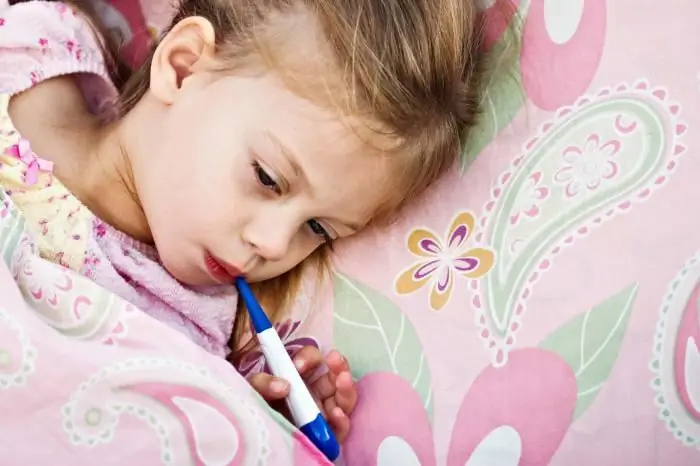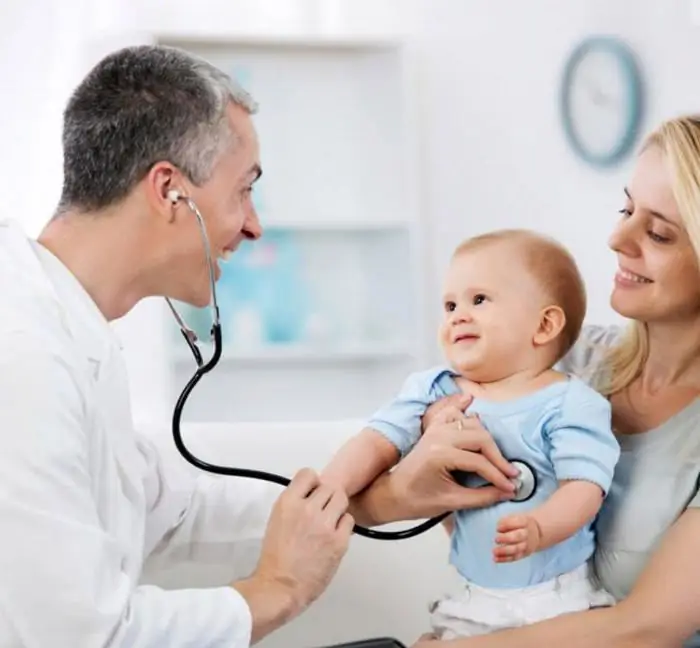2025 Author: Priscilla Miln | [email protected]. Last modified: 2025-01-22 17:55:26
An increase in body temperature during illness rarely causes adults to call an ambulance, and many go to the local therapist only for sick leave, if necessary. Today, it is customary to carry diseases on your feet and not waste time on bed rest, since pharmaceuticals offer a wide range of drugs to combat symptoms.
Adults can afford not to go to the doctor when the temperature rises, but it is unacceptable for parents to ignore a fever in a child, since the decrease in child mortality in our century has been due to the achievements of modern medicine, which provides timely assistance to small patients.

There are emergencies where medical professionals must intervene immediately, so parents need to know what temperature to call an ambulance for a child.
What is a normal temperature for a baby?
Many know thatthe classic 36.6 degrees is not an indicator of normal temperature for everyone, since metabolic processes occur in the body in each person in different ways. For children, this is even more true, since thermoregulation in a growing body is only being formed and strongly depends on the age and activity of the child.

If a baby in the first months of life has a body temperature of 37-37.4 degrees, but there are no symptoms of the disease, appetite and stool are normal, the child is active, there is nothing to worry about. The thermoregulation system will improve in a few weeks, and the body temperature at rest will not exceed 36.8 degrees. However, excessive wrapping and heat can greatly affect the thermometer reading, so the baby must be comfortable and not wrapped up.
Fever may be normal for baby
After massage, crying, feeding, the baby's temperature may rise slightly, which is normal. The first hours after vaccination can also provoke an increase in this indicator.
A child after active games, especially in the heat, can get hot and sweat naturally, but even under such conditions, the thermometer should not rise above 37.4 degrees.

For some children, a temperature of 37 degrees is normal. However, if earlier the usual indicator for a child was 36.6 degrees, but after an illness within a week or twothe thermometer shows 37-37, 3 degrees, you can suspect a hidden inflammatory process, which is the reason for going to the doctor. He will examine the little patient and prescribe the necessary tests.
When to watch out?
In the vast majority of cases, parents can independently cope with a fever in a sick child with the usual medical and physical means. However, experienced moms and dads know at what temperature a child needs to call an ambulance immediately.
The general rule is this: the younger the baby, the greater the risk of negative consequences of ignoring the high temperature. For infants, a thermometer reading over 40 degrees is a definite reason to immediately call the ambulance, especially if the child is not even three months old.

Associated symptoms in the form of rash, vomiting and abdominal pain, the presence of blood in the stool and vomit are a signal to seek medical attention, no matter at what temperature. An ambulance should be called for the child immediately if the suddenly rising temperature for half an hour could not be brought down with antipyretics.
What to do before the doctors arrive?
While waiting for the ambulance, you need to free the baby from clothes and diapers, put him on an oilcloth with a sheet, cover with a diaper and wipe with warm water, drink plenty of water. Periodically, temperature measurement must be repeated, tracking the dynamics.

The child is notshould be cold, because as a result of contact with cold air or water, the vessels on the surface of the skin will narrow. This will make heat dissipation difficult and will only make things worse.
It is forbidden to wipe the child with vinegar and alcohol-containing liquids, which can be absorbed into the skin and cause poisoning, not to mention burns the baby's delicate respiratory tract.
It is forbidden to exceed the dosage of antipyretics without an individual recommendation of a doctor.
Parents of children who react to fever with febrile convulsions should know from experience at what temperature to call an ambulance to a child. As a general rule, in such cases, they do not wait for the temperature to rise above 38 degrees and, if measures to reduce it do not work, call the ambulance.
When is heat good for a baby?
The concern of inexperienced parents is easy to understand if a one-year-old child has a temperature of 39 degrees. At the same time, the baby may look lethargic, cry and act up, but it also happens that the high temperature does not affect either the appetite or the baby’s sleep, and only a hot forehead and flushed cheeks give out malaise.
It is known that by increasing the body temperature, the body is activated to fight foreign viruses and bacteria, releasing interferon and special immune cells. Therefore, doctors do not recommend bringing down the temperature if the thermometer does not rise above 38.5 degrees. This does not apply to children with a history of febrile seizures.
High fever without symptoms
There are cases when a child's illnessproceeds not according to the usual scenario of "runny nose - cough - fever". It also happens that as soon as the pathogen becomes a target of the immune system, the child develops a high temperature without symptoms.

The reasons for the absence of any signs of infection of the gastrointestinal tract or respiratory system lie in the fact that, most likely, the virus is not stationed in them. Doctors also suggest that after a couple of days of fever without symptoms, the child does not show any signs of illness due to the fact that his immune system successfully coped with the invasion of the "enemy". In this case, the child should be shown to the doctor to make sure of recovery.
Overheating as the cause of an increase in body temperature
There is also a very simple reason that a child has a temperature of 38. Should I call an ambulance if there are no other symptoms, and the child does not express concern? Before dialing an ambulance, it is worth checking if the child is overheated, if he is not too wrapped up, if his bed is near the radiator, if he has overheated as a result of an active game or a walk under the scorching sun.
Overheating can often explain a high fever in a child without symptoms. The causes of this condition must be immediately excluded. To do this, you need to eliminate the alleged inconvenience and create comfortable conditions for the baby: cool and humid air, coupled with plenty of fluids. The temperature should return to normal within 30 minutes.
How long does a fever normally last?
Fever, includingwithout symptoms, should not last more than three days, since prolonged fever may indicate a complication of the disease. A negative factor is also considered a repeated rise in temperature after the child has not suffered from fever for several days. Such situations require mandatory medical examination.
Parents usually know from experience how long a child's fever can last, because children are different and the reaction of the body is individual. This allows them to calmly meet the next temperature rise in the baby and not panic. Usually body temperature returns to normal on the fourth day. Otherwise, you need to call a doctor at home.
Doctors advise young mothers and fathers to carefully monitor the condition of newborns and children of the first year of life with a fever. If it is difficult for the baby to tolerate, alarming symptoms appear in the form of a rash, vomiting, diarrhea, febrile convulsions, difficulty breathing, the question of at what temperature in a baby to call an ambulance becomes more acute, since in this situation it is urgent to alleviate the condition of the crumbs, regardless of thermometer readings. Sometimes delay can cost him his life.
Temperature in children over 1 year old
Parents of infants are more likely than others to wonder at what temperature to call an ambulance to a child. 1 year is a special age for a baby, because his body is already adapted to the environment. And his mom and dad now know how their child reacts to the heat, and know how to help him.
By this time, in the absence of neurological diseases that entailfebrile convulsions, the thermometer ceases to frighten parents, even when it shows that the temperature is 38. Should I call an ambulance at a higher temperature in children of this age? Yes, if rubbing with warm water, drinking plenty of water and airing, coupled with antipyretic drugs, do not work.
Dehydration can be a serious problem for a baby, even if the cause of the fever lies in the banal SARS. In a one-year-old child, a temperature of 39 degrees, which is stable for 1 hour, ceases to be useful. This is not limited to babies, so an ambulance call is essential.

Since the body of each person, adult or child, is unique, the answer to the question of at what temperature an ambulance should be called for a child does not have a clear answer. Parental intuition, careful observation of the child and regular consultations with a pediatrician and a neurologist are much more effective than universal advice that is fair for some children and unacceptable for others.
And yet, when it comes to the he alth and life of a little person, especially in the first months of his life, it is better to be excessively vigilant than to be tormented by doubts and reproach yourself for inaction.
Recommended:
Should I call a man first? When can you call first? Women's secrets

Building a relationship with a man is an art. Many girls do not master it perfectly, so they make frequent mistakes. Due to banal errors and their own stupidity, even the most beautiful young ladies can remain lonely. One of the most sensitive questions that any girl asks: is it worth calling a man first? Find the answer below
How to affectionately call your beloved? How to call your girlfriend?

It's no secret that people in love some time after the start of a romantic relationship begin to call each other not only by name, but also give each other affectionate nicknames
Baby does not sit at 9 months: reasons and what to do? At what age does the baby sit down? What should a 9 month old baby know?

As soon as the baby is six months old, caring parents immediately look forward to the fact that the child will learn to sit on his own. If by 9 months he has not begun to do this, many begin to sound the alarm. However, this should be done only in the case when the baby cannot sit at all and constantly falls to one side. In other situations, it is necessary to look at the overall development of the child and draw conclusions based on other indicators of his activity
At what temperature should I give an antipyretic to a child? Effective drugs

Any mother would like her child's he alth to always remain in good condition. And it's very bad when the child starts to get sick
Convulsions at a temperature in a child. Help with cramps. How to bring down the temperature of 39?

One of the common symptoms of viral infections is a significant increase in temperature, while children often begin to have convulsions. The article contains information on how to help the baby in such cases

